With the spring in full bloom can it be great to take class outdoor.
Here are some activities concerning different aspects of mathematics.
Outdoor mathematics (PDF, 453 kB)
Mötespunkt för pedagoger att dela naturvetenskapliga idéer
With the spring in full bloom can it be great to take class outdoor.
Here are some activities concerning different aspects of mathematics.
Outdoor mathematics (PDF, 453 kB)
Med våren i full blom är det härligt att ta lektionen ut.
Här finns en samling av olika aktiveter att fundera kring matematik på olika sätt. Alla för utomhusbruk.
Utematte (PDF, 495 kB)
STEP 1: Make predictions. Which object will fly the farthest? Why do you think one will fly farther than the other?
STEP 2: Hand out supplies to each individual or in small groups, and build a Popsicle stick catapult following the instructions below.
Read more about the science behind the catapult and simple ways to create a catapult science experiment below!
STEP 3: Test and measure how far each item goes when flung from the catapult. Record results.
You will want to use a pair of scissors to make two v notches on either side of two jumbo craft or Popsicle sticks (in the same place on both sticks). Use the photo below as a guide for where to make your notches.
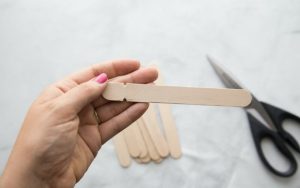
Once you have made your notches in two of the sticks, set them aside!
Take the remaining 8 craft sticks and stack them one on top of the other. Wind a rubber band tightly around each end of the stack. Go ahead and push one of the notched sticks through the stack under the top stick of the stack.
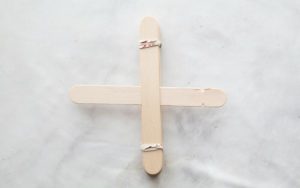
At this point flip your partially made popsicle stick catapult over so that the stick you just pushed in is on the bottom of the stack.
Lay the second notched stick on top of the stack and secure the two popsicle sticks together with a rubber band as shown below. The V notches that you cut help to keep the rubber band in place.
Create more leverage with your catapult by pushing the stack of popsicle sticks towards the notched ends connected by the rubber band.
Use sticky dots or another strong adhesive to attach a bottle cap to the popsicle stick. Get ready to fire away!
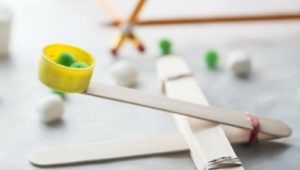
You can easily set up an experiment by testing different weighted items to see which ones fly farther. Adding a measuring tape encourages simple math concepts that my 2nd grader is just really starting to explore.
Or you can build 2-3 different catapults and see which one works better or if one works better with different objects.
Always start out asking a question to come up with a hypothesis. Which item will go farther? I think xyz will go farther. Why? Have fun setting up a catapult to test the theory! Can you design a different catapult using the same materials?
Additionally, you can encourage older kids to record the data from measuring all the launches. Have your kids fire each material {such as a candy pumpkin, plastic spider or eyeball} 10 times and record the distance each time. What kinds of conclusions can they draw from the information gathered? Which item worked the best? Which item didn’t work well at all?
You can also test out the number of popsicle sticks used in the stack to create the tension need to launch the catapult. How about 6 or 10! What are the differences when tested?
What is there to explore that has to do with physics? Let’s start with energy including elastic potential energy. You can also learn about projectile motion. Newton’s 3 Laws of Motion: An object at rest stays at rest until a force is applied, and an object will stay in motion until something creates an imbalance in the motion. Every action causes a reaction.
When you pull down the lever arm all that potential energy gets stored up! Release it and that potential energy gradually changes over to kinetic energy. Gravity also does its part as it pulls the object back down to the ground.
You can talk about stored energy or potential elastic energy as you pull back on the Popsicle stick, bending it. When you release the stick all that potential energy is released into energy in motion producing the projectile motion.
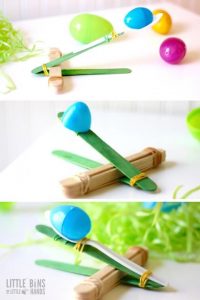
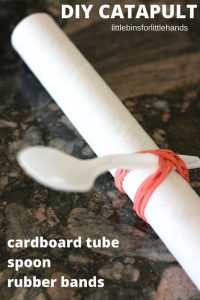
Idéa take from littlebinsforlittlehands
STEG 1: Gör ett antagande. Vilket föremål kommer att flyga längst? Varför tror du att det ena objektet kommer att flyga längre än det andra?
STEG 2: Dela ut material till varje enskild person eller i små grupper och bygg en katapult av glasspinnar enligt instruktionerna nedan.
STEG 3: Testa och mät hur långt varje föremål går när det kastas från katapulten. Registrera resultaten.
Du ska använda en sax för att göra två v-spår på vardera sidan av två pinnar (på samma ställe på båda pinnarna). Använd fotot nedan som en guide för var du ska göra dina skåror. När du har gjort dina skåror i två av pinnarna lägger du dem åt sidan!

Ta de återstående 8 pinnarna och stapla dem på varandra. Linda ett gummiband hårt runt varje ände av stapeln. Gå vidare och skjut in en av de inskurna pinnarna genom stapeln under den översta pinnen i stapeln.

Vänd nu din delvis tillverkade katapult med glasspinnar så att den pinne som du just har tryckt in ligger längst ner i stapeln.
Lägg den andra inskurna pinnen ovanpå stapeln och fäst de två isglasspinnarna med ett gummiband så som visas nedan. De V-kanterna som du skar ut hjälper till att hålla gummibandet på plats.
Skapa mer hävstångseffekt med din katapult genom att skjuta stacken med pinnar mot de inskurna ändarna som är sammanfogade med gummibandet.
Använd ett starkt lim för att fästa ett flasklockshuvud på pinnen. Gör dig redo att skjuta iväg!

Du kan också göra en katapult med en sked, som är särskilt bra för att hålla föremål som påskägg i plast eller falska ögonglober. Se två sätt att placera skeden nedan!


Du kan enkelt sätta upp ett experiment genom att testa olika viktade föremål för att se vilka som flyger längre. Att lägga till ett måttband uppmuntrar enkla matematiska begrepp.
Eller så kan du bygga 2-3 olika katapulter och se vilken som fungerar bäst eller om en fungerar bättre med olika föremål.
Börja alltid med att ställa en fråga för att komma fram till en hypotes. Vilket föremål kommer att gå långt längre? Jag tror att xyz kommer att gå längre. Ha kul med att sätta upp en katapult för att testa teorin! Kan du konstruera en annan katapult med samma material?
Du kan också testa hur många glasspinnarsom används i stapeln för att skapa denspänning som behövs för att skicka ut katapulten. Vad sägs om 6 eller 10! Vilka är skillnaderna när du testar?
Vad finns det att utforska som har med fysik att göra? Låt oss börja med energi, inklusive elastisk potentiell energi. Du kan också lära dig om projektilrörelse. Newtons tre rörelselagar: Ett föremål i vila förblir i vila tills en kraft appliceras, och ett föremål förblir i rörelse tills något skapar en obalans i rörelsen. Varje handling orsakar en reaktion.
När du drar ner hävstångsarmen lagras all potentiell energi! Om du släpper den så övergår den potentiella energin gradvis till kinetisk energi. Gravitationen gör också sin del när den drar föremålet tillbaka ner till marken.
Du kan prata om lagrad energi eller potentiell elastisk energi när du drar tillbaka på isglasspinnen och böjer den. När du släpper pinnen frigörs all potentiell energi till rörelseenergi som ger upphov till projektilrörelsen.
Idé från littlebinsforlittlehands
 Helsingfors Universitet och LUMA-center har gjort en sagobok där olika matematiska idéer presenteras med hjälp av berättelser.
Helsingfors Universitet och LUMA-center har gjort en sagobok där olika matematiska idéer presenteras med hjälp av berättelser.
Den innehåller även praktiska idéer för hur man kan åskådliggöra idéerna för gruppen och frågor för diskussion.
Materialet hittas här: Lelas matematikäventyr på dagis (helsinki.fi)

A simple game in Battleship style which you can combine with discussing the the effect of pollution on sealiving creatures.
Game and rules: New-Save-the-Whale-Treasure-Hunt (PDF, 1262 kB)
Idea taken from littlebinsforlittlehands.com

Ett spel i sänka fartyg stil där man samtidigt kan fundera kring nedskräpning av haven och vad det innebär för djuren som lever i haven.
Spelplan och regler: Rädda valen (PDF, 627kB)
Idé från littlebinsforlittlehands.com
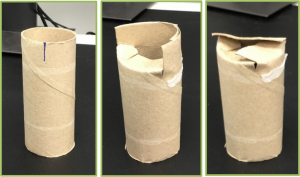
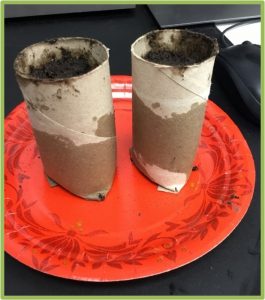
Let the rolls stand and germinate, preferably in a trough.
Bönor och ärtor är perfekta att plantera i toarullar – de vill nämligen växa i fred och inte i jorden tillsammans med andra eftersom rötterna blir störda. En egen liten kruka i form av en vanlig toarulle är därmed en perfekt lösning.


Låt sedan rullarna stå och gro, helst i ett tråg.
 Material
Material Goal
GoalHypothesising. Test and evaluate.
 Preparation
PreparationDivide the children into groups of three. One performs, one takes time and one documents.
 How do you do it?
How do you do it?Make hypotheses like; I have time to get to the tree, run a lap around and come back. Get the children to think and come up with their own hypotheses and then perform.
Take turns and switch roles.